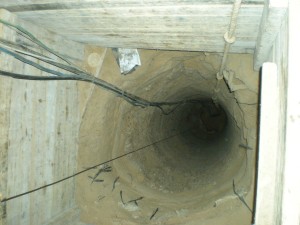Day Two in Gaza by Gerri Haynes
(For the next week or so, I will be running a guest blog by Gerri Haynes, a former president of Washington Physicians for Social Responsibility. Gerri, a nurse from Kirkland, Wash., is in Gaza with 11 other people in an effort to help the people there and also to better understand the situation.)
The sun shines brightly – destruction from the attacks this past winter become more apparent. Bombed shells of buildings await repair – importing concrete is forbidden. Some single story buildings are being constructed of mud bricks readily available from the earth of this country. Injured bodies appear in clinics. Injured hearts and minds are universal – everyone has a close experience to the latest war on the people of Gaza.
The physicians in our group, Bill Dienst, Dave Hall, Laura Hart, Bob Haynes, Don Mellman and Bryan Saario are meeting with colleagues and seeing patients. Some surgeries have been completed and many cardiology patients have been served. Consultations by Dave Hall, psychiatrist, reveal the ongoing trauma of living in this pain-filled environment.
A group of mental health professionals participated in the first day of a two-day conference on grief and mourning – facilitated by me. Elliott Adams, Will Covert, Cherie Eichholz, Anne Hall and Jack Smith, members of our delegation designated as the human rights group, traveled the length of Gaza. Their observations of the effects of the four years of siege and repetitive attacks will be documented here in the next days.
Jack Smith wrote today: “I’ve seen the bombed-out buildings, the tunnels that are used to bring basic supplies – food, clothing, fuel, medicine – into Gaza from Egypt, saw where Rachel Corrie was murdered, talked with a farmer who could not ship his strawberries outside the border of Gaza, talked with people who, like the strawberries, could not leave Gaza, learned that structures cannot be rebuilt or replaced because building supplies are not allowed by Israel to enter Gaza. I saw the destroyed juice-processing plant, the industrial facility destroyed by white phosphorus, talked with workers who did not speak English (I don’t speak Arabic), but somehow connected. I am learning to love the Palestinian people – people who state they do not know why they are imprisoned and attacked. My goal for the coming days is to keep caring and to show it – to learn more and commit to sharing in the US what I learn here.”
Between 400 and 600 tunnels exist at the southern border between Gaza and Egypt. These tunnels are routinely targeted by Israel, but new tunnels are continuously dug – they are a lifeline for the people of Gaza. And they are dangerous. Tunnel collapses have taken an estimated 200 lives. Goods coming through the tunnel are taxed. A tunnel-digging industry now exists. Egyptians reportedly await those who enter Egypt, stamping entry visas on passports (for a fee). The tunnels are a physical statement about human need and desperation.
Human relationships are essential to survival. The Dean of the Faculty of Medicine at the Islamic University of Gaza visits his mother every day. He finishes his work and, before continuing with his evening, stops to visit his octogenarian mother. She kisses his hands and feeds him whenever there is time or need – he is her child and they know love and security in these daily visits.

One of the tunnels linking Gaza and Egypt.
1 Comment to “Day Two in Gaza by Gerri Haynes”
-
Day Two in Gaza by Gerri Haynes | Looking for Trouble | Mobile Wireless Phone — October 27, 2009 @ 7:50 am
RSS feed for comments on this post. TrackBack URI